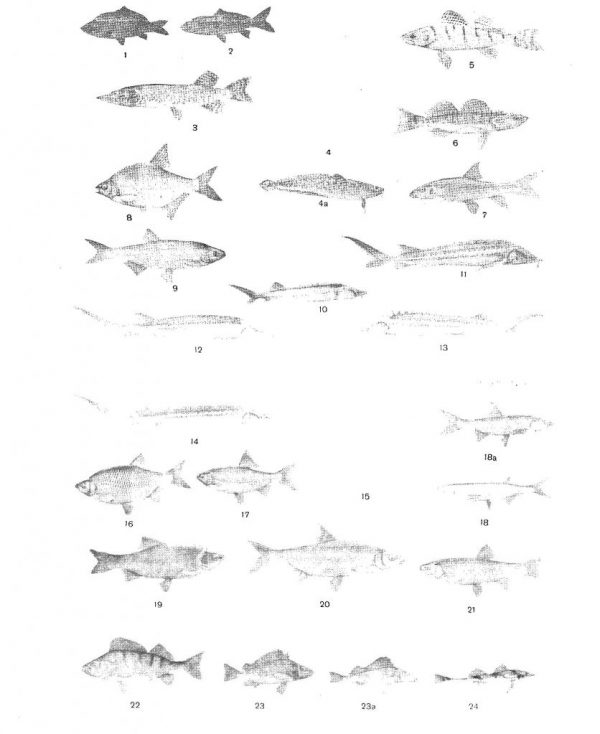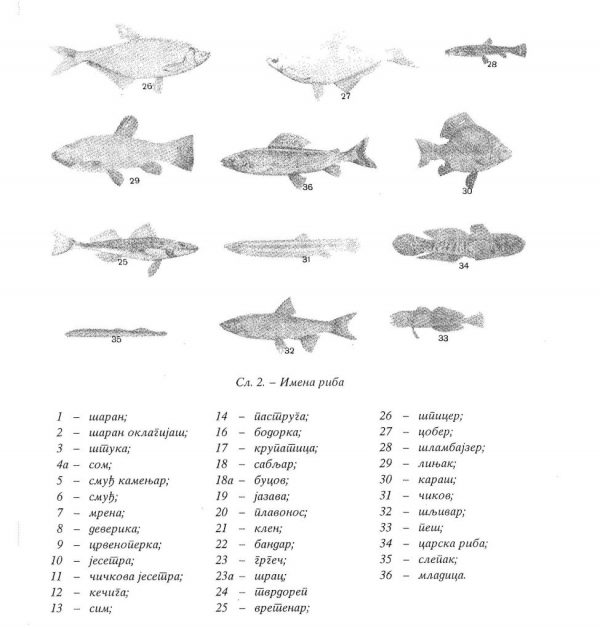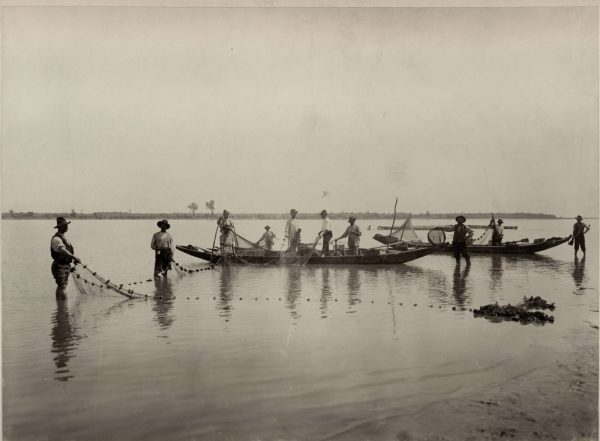ABOUT FISHING AND LITERARY WORKS OF MIHAILO PETROVIĆ ALAS
Mihajlo Pantić
PEOPLE LIKE ALAS ARE FEW AND RARE. Among all his occupations and interests, and there were enough of them to fill up two lifetimes to the brim, Mihailo Petrović Alas attached undeniable importance to his primordial passion – fishing. After all, it is fishing that earned him his nickname, by which he has been permanently remembered in Serbian history, science and culture. (According to some testimonies, the nickname was initially ironically coined by Milutin Milanković, another tremendous Serbian scientist of that time. However, later on it became his standard hypocorism, which, as is the custom of the Serbian cultural environment, underlined broad popularity and affection that Alas generated; it is enough to say – Alas – and right away everyone knows.)

Portrait of Mihailo Petrović from 1921. (Collected Works, Book 14) (Digital Legacy of Mihailo Petrović)
Petrović’s passion for fishing eventually grew into a specific worldview, and became a distinctive, practiced and defined “philosophy of life.” Numerous available data and records, and certain outright gestures of Alas’s (eccentric, in the true master river fisherman, the “alas”, vein). evidence of the power of such passion. Publicist Predrag Đuričić, son of Alas’s friend Mladen St. Đuričić who remembered the great Serbian scientist from his childhood, wrote in his article “Personality of Mihailo Petrović Alas in Memories and Anecdotes” that it was his father who brought his attention to Alas’s unusual nature. One day his father showed him “Mihailo Petrović’s study, and on the wall above the typewriter stood only one diploma. It was a master’s letter, written in rough, unskilled handwriting of a river master fisherman, and signed by the president of the commission, that Mihailo Petrović, a professor, has passed the master’s exam for a master river fishermen, and is now certified in the fisherman trade, which the undersigned members of commission recognize and confirm.” Besides all his academic honors, honorary doctorates, and membership in the world’s most renowned scientific associations, Alas saw himself, first and foremost, as a hardcore master fisherman, his life oriented towards water and the brotherhood of men united in their enthusiasm for fishing.
His highly extensive and diverse interdisciplinary scientific work has been systematized on several occasions, yet constant study and re-examination are still required, now supported by the publication of The Collected Works, a most comprehensive presentation so far (15 volumes, editor-in-chief Dragan Trifunović, 1997). In addition to this, throughout his life, Mihailo Petrović Alas dedicated his time to the theoretical and practical aspects of ichthyology, the fish science. Permanently, almost providentially fascinated by the fish world, he was familiar with the tiniest details of nature, tradition and all the techniques of river fishing, especially on the Danube and Sava. As an aficionado and a practitioner, a member of the trade circle, Alas relentlessly – even obsessively – explored, described and interpreted customs, language, tools, the mundane as well as the extraordinary scenes from the life of this seemingly marginal, but a very picturesque and authentic social stratum at the turn of the centuries, and also before and after the Great War.
Mihailo Petrović Alas’s writings about fishing can be divided into four groups, conditionally speaking. The first group is ichthyological in the strict sense of the term (listing and describing fish species). The second deals with the fishing skill and methods, displaying and mapping fishing locations, cataloging different tools and baits, as well as technologies for fish storing and processing, and finally, instructions for fish breeding. The third group is about the history of fishing in Serbia. Starting from the ancient era, he writes about the times under the Ottoman Turks, when fishing was very developed (Turks held the deeds over river fishing), and all the way to Alas’s time, including also the history of the fishing guild, and regulations pertinent to the fishing industry. The fourth group includes literary expressions of his existentially privileged passion (travel books, reportages, popular articles, such as “Do Fish Sleep?”, or the strange historical fragments, such as: “An Unusual Fish Adventure in the Court of Emperor Napoleon III”).
A separate group, indirectly linked with fishing, includes Petrović’s papers on hydrography and oceanography. Standing out in this group is his most detailed and most famous popular science novel, The Eel Novel. Indicating genre in this, at first glance, unusual title, does not so much refer to this most widespread fictional form, as it implies its broader meaning. Labeled as a “novel,” Petrović’s books presents an exciting, realistic but also mysterious, stylized and well-shaped account, with a defined theme, time, space and narrative instinct.

The Belgrade Fishery Association confers a diploma to its founder Mihailo Petrović on July 12, 1942. (SASA Archive, 14188/33)
The Eel Novel begins with an explanation as to why the author wrote it. Alas notes: “Once, the eels were regarded as creatures with no known beginning or end. The question of how an eel was born was a puzzle that exasperated the curiosity and imagination of both naturalists and philosophers. It also intrigued Aristotle, who found that eels were an unsolvable puzzle, and could not grasp how an eel’s life ended. This mystery confounded the world to such an extent that, once it appeared that no one was able to say anything about it, general opinion formed that it was unsolvable, forever inaccessible to human reasoning, and extending into the realm of religious mysteries. Writing about eels, Herodotus said that it was a sacred creature that only the divine could look after.”
In the Middle Ages, Petrović writes, eels continued to be viewed as evidence of the divine. Such evidence, he asserts, “must be compelling even for the most pungent of atheist”. And it is a long time common understanding that every mystery, not just that of an eel, must have a poetic overtone; otherwise, it would not be a mystery. Izaac Walton, in The Compleat Angler (1653), undoubtedly the most famous book in the world which tackles the topic of fishing in a literary fashion, in an attempt to shed light on the mystery of eel propagation, states, among other, that eels are “bred of mud, as some worms […] or out of putrefaction of the earth […] similar to certain bees and wasps”; that eels are “spawned of a particular dew descending in the months of May or June on the banks of some particular lakes or rivers […] and the ancient peoples called them the offspring of Jove”, adding that “eel’s spawn is born alive, and that tiny live eels, no bigger than a pin, come out of an eel.”


Types of fish in Belgrade hunting areas (Collected Works, Book 14) (Digital Legacy of Mihailo Petrović)
Petrović’s Eel Novel offers the reading public a retrospective of the solutions proposed to the two-millennium-old eel mystery in a lucid, accessible manner. He starts with the discoveries made by the naturalists Redi and Mondini in the 17th century, refers to Sirevi and Jakobi from the second half of the 19th century, and Grasi and Fezersen in the late 19th century. He finishes with the famous Johannes Schmitt, whose research in the first half of the twentieth century took twenty-five years. After all the confusion, temptation and enigma, Schmidt produced an exhaustive scientific description of the breeding process of this mysterious fish. Eels might not be of a divine origin, but they undeniably illustrate the immense and inexhaustible imagination of the divine mother nature, inaccessible to the human mind. Seeking to scrouplously present and interpret many questions which ichthyology encountered in sheding light on the eel secret, Mihailo Petrović Alas traveled to the eel breeding waters in the Atlantic Ocean. In his “novel” he offers a series of extraordinary reports about those places, filled with unusual, intriguing, sometimes almost incredible but always striking details, corroborated by experience and also scientifically. It is such impressions that push Petrović’s writing beyond the boundaries of the documentary genre, revealing it as attractive for a reader, linguistically inspired outlook, rooted in individual experience, with an appropriate, recognizable, nuanced, narrative tone of an experienced author. This also opens up the question of whether Petrović’s prose of this type, at least at the secondary level, can be read and regarded in the context of literary art.

Cover page of The Eel Novel, published in 1940. (eLibrary Faculty of Mathematics, University of Belgrade)
By all means so. Being a declared rationalist, a scientist who believes in facts and practical evidence, Mihailo Petrović Alas never consider himself a writer, and rejected the thought that others saw him as such, demonstrating suspicion towards the human need for imagination, and in particular for the banal “poetry” and the overtly artificial “theater.” At the same time, a significant part of his opus was shaped in line with the literary requirements and using literary means, complying with an inherent rule that an author’s writing style influences the image presented. Not only in his many travel journals, which are eminently literary in genre, Petrović is also a writer of a striking style in his other non-scientific texts. His style is neither expressive nor lyrical in the way of the best writers of his time, but it manages to be very suggestive. The subject matter is communicated quickly and easily to the reader.
By preferring credibility and “objectivity” in his writing, Alas approaches realistic tradition, which he particularly appreciates. He makes direct mention of this in his well-known text, “An Unfinished or Lost Narrative by Stevan Sremac.” According to Petrović, this epitome of Serbian literary realism, a personal friend of Petrović’s, had every intention of writing a story about a river fisherman way of life. Sremac visited this world, made notes about it, but only his concept remains to this day, thanks to Alas.

Folding of a large fishing net (a dragnet, alov) into a boat (SASA Archive, 14197/6)
Many critics have written about the literary quality of Petrović’s texts (among them: Milan Bogdanović, Mihailo Pavlović, Dragan Trifunović, Slobodanka Peković). All share a prevailing opinion that Petrović is a master of a functional, reporting style, an engaging narrator, focused on precisely presenting the theme. He is in complete control of the form and the narrative rhythm, skillfully managing the relationship, and proportion, between the main topic and digressions, finding a balance between the document and his own experience. All that points to his rational, scientific nature, his emotionally balanced presentation, and clear, positivist-influenced tendency towards the exact, rational facts. (This can also be somewhat disputed: Mihailo Petrović Alas was also a passionate reader of adventurous and science fiction novels, and he was especially interested in the relation between science and poetry, and has written a study on that very subject.) Alas’s language is precise, occasionally with mildly archaic overtones. Particularly precious is his vocabulary, well suited to his subject matter, professional and academic in tone when required, but also colloquial when describing life itself (for example, river fishermen’s nicknames, tools, professional jargon, etc.). This is true for his travelogues, his texts on fishing, but also for some of his essays and articles, several of which are in fact full-fledged stories, without the excessive poetic stylization (“One Great Muslim Pirate,” “Gymnasium Time Memories,” “One Iron Gate Gorge Experience,” “Mija Jagodinac, the Music Maker”).

Mihailo Petrović with a caught catfish, weighing 124 kilograms (December 5, 1913) (SASA Archive, 14188/28)

Three faces of Mihailo Petrović as a fishery master on the Sava and the Danube rivers. Petrović maintained an extensive correspondence with the world. He used his own seal to secure a postal package or an envelope. His stamp depicts a “fish eating a fish” with MP initials, hardly a coincidence (the stamp was made in Paris, of silver and yew tree wood, Taxus baccata, in 1898). (Collected Works, Book 14) (Digital Legacy of Mihailo Petrović)
Standing apart from the rest, but remaining an indirect relationship with other scientific and existential interests of Mihailo Petrović, is his unfinished phenomenological study Metaphors and Allegories (Metafore i alegorije), posthumously published in 1967 by the Serbian Literary Cooperative, otherwise publisher of many Alas’s books. He begins by describing the properties of metaphor, that universal, generative literary stylistic tool, and also of allegory as a particular artistic tool for conveying and crystallizing meaning. Petrović then goes on to address the issue extensively, and looks into the types of transposing and conversion, in other words, of establishing a network of analogies which is then used as a basis for both scientific and creative thinking. His paper finishes with the systematization of typical usages and roles, in an attempt to get as close as possible to the otherwise unattainable principle of phenomenological “absolute adequacy.” In the words of Dragan Trifunović, the editor of the first edition of the “Metaphors and Allegories,” “Petrović successfully uses these literary figures of speech and develops a compelling theory of similarity, as yet another contribution to his “extended mathematics.”
Let us go back to the beginning. Looking back from a distance in time, during which the world rapidly accelerated and transformed in the way that our ancestors could never have dreamed of, Petrović’s unique creative personality is an instance of harmonious, optimal realization of all potentials of an individual, incomparable by any standard. Equal importance should be attached here to the roles played by his reason and his passion. Petrović’s passion, fishing, harked back to the deepest, archetypal, collective forces of the humankind. Having fulfilled the hunting instinct, this passion comes back to focus on the general, mysterious laws which are at work behind the entire existence of the living world, and it both becomes and remains an integral part of it. There are few of its enchanted captives who managed to gain conscious control over it, and shed as much light on it as possible, and to the extent accessible to humans. Petrović is, beyond any doubt, a representative of this minority.
After all is said and done, it is worth repeating – men like Alas are few and rare.